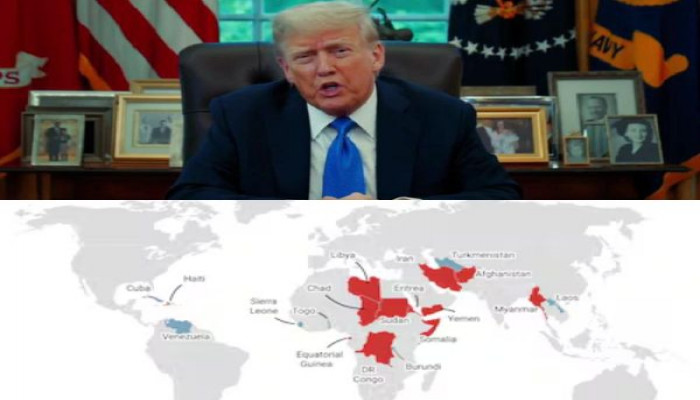Trump announces travel ban on 12 nations, imposes visa limits on 7 others
- In Reports
- 05:57 PM, Jun 05, 2025
- Myind Staff
Almost five months into his second term, President Donald Trump signed a new travel ban on Wednesday. The order barred people from entering the United States from 12 countries and placed visa restrictions on seven others. The move revived Trump’s immigration agenda from his first term. He said he wanted to address a potential surge in immigration.
The new ban was scheduled to take effect at 12:01 a.m. on Monday, June 9, giving travellers and government agencies a short time to adjust.
A travel ban is a federal policy that blocked or limited nationals from certain countries from entering the United States. The restrictions could block all travel or suspend specific visa categories.
Trump signed this order as a continuation of his first-term policy of banning travel from several countries. Five of those countries appear again in this new order.
The ban came days after a deadly attack in Boulder, Colorado. Authorities said an Egyptian national was behind the attack. Egypt was not part of the ban. However, Trump used the attack as a reminder of the risks for individuals who overstayed visas or came from countries with weak screening practices.
The new order grouped the countries into two categories. The first group faced a full travel ban. The second group faced visa restrictions. Most of the countries were in Africa, the Middle East, and Latin America.
The countries under a full travel ban are Afghanistan, Chad, the Republic of Congo, Equatorial Guinea, Eritrea, Haiti, Iran, Libya, Myanmar, Somalia, Sudan and Yemen. Countries facing visa restrictions include Burundi, Cuba, Laos, Sierra Leone, Togo, Turkmenistan and Venezuela.
The Trump administration listed three reasons for selecting these countries: Afghanistan, Libya, Eritrea, Somalia, Sudan, Yemen and Venezuela lacked secure document systems or strong screening measures. The second category- Myanmar, Chad, the Republic of Congo, Equatorial Guinea, Haiti, Burundi, Laos, Sierra Leone, Togo, and Turkmenistan had high visa overstay rates in the U.S while the last category- Iran, Afghanistan, Somalia, Libya, Cuba and Sudan has links to terrorism or state-sponsored terrorism.
The ban made exceptions. It exempted green card holders and people with a pathway to U.S. citizenship. It also exempted those with dual citizenship, including one from the U.S. and another from a listed country. The order states that people applying for visas based on close family relationships with U.S. citizens were not affected.
The order also exempted athletes and coaches, along with their families, who travelled for sporting events. The exemption is related to the U.S. hosting the 2026 World Cup and Los Angeles hosting the 2028 Summer Olympics.
The ban exempted refugees who had already been granted asylum. Afghan nationals who had supported the U.S. government during the post-9/11 war were also exempted.
The order also exempted Iranians fleeing religious persecution, especially Christians and members of minority religious groups.
The new ban differed from Trump’s 2017 travel ban. In January 2017, Trump signed an executive order that banned travel from seven Muslim-majority countries. That order led to confusion at airports, legal challenges and protests. The administration revised the order multiple times. The Supreme Court upheld the final version in 2018.
Unlike the 2017 order, the new proclamation allowed a short window before implementation and included specific exemptions.
Trump began issuing travel bans in January 2017. On January 27, 2017, he signed the first ban. It barred people from Iran, Iraq, Libya, Somalia, Sudan, Syria, and Yemen from entering the U.S. for 90 days. On February 3, 2017, a federal judge blocked that order in the case of Washington v. Trump. On March 6, 2017, Trump issued a new order. It removed Iraq from the list and exempted green card holders and those with valid visas. On March 15, 2017, two federal judges blocked core sections of the revised order. They said the section that banned travel from six countries could not be enforced.
On September 24, 2017, Trump issued a third travel ban. It barred most citizens from Chad, Iran, Libya, North Korea, Somalia, Syria, Venezuela, and Yemen from entering. It made exceptions for Iranian nationals with valid student and exchange visitor visas. On December 4, 2017, the Supreme Court allowed that version to go into effect while legal challenges continued. On April 10, 2018, Trump removed Chad from the list after it improved its security procedures.
On June 26, 2018, the Supreme Court upheld the third version of the travel ban in a 5–4 ruling. The court said the president had the authority to act on national security concerns involving immigration.
On January 31, 2020, Trump signed a fourth travel ban. It barred immigrants from Eritrea, Kyrgyzstan, Myanmar, Nigeria, Sudan, and Tanzania. The order did not apply to tourists or people visiting temporarily.
On January 20, 2021, President Joe Biden took office and revoked all of Trump’s travel bans on his first day.







Comments